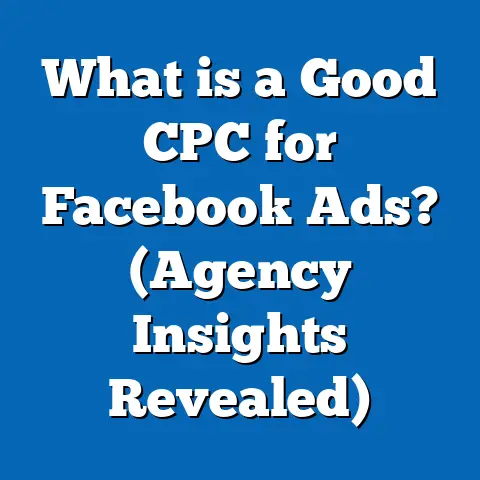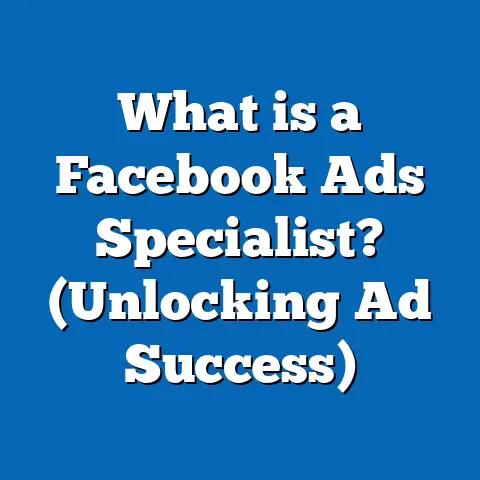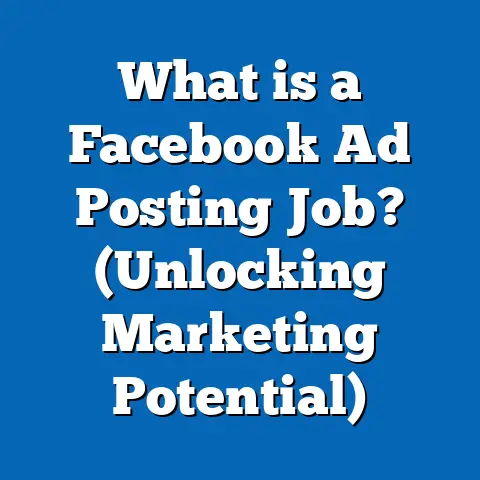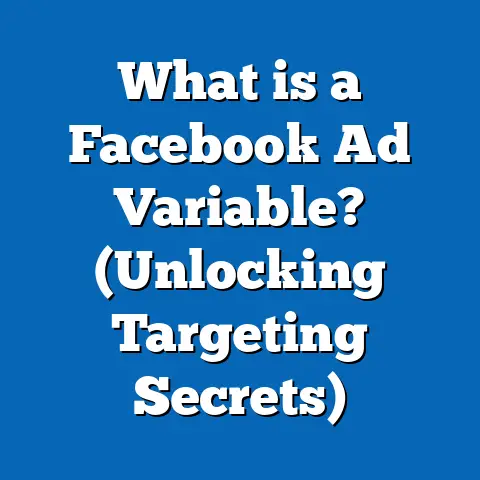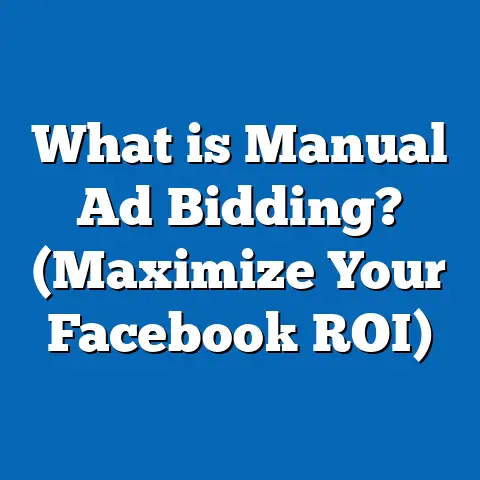What is the Best Audience for Facebook Ads? (Unlock Targeting Secrets)
What is the Best Audience for Facebook Ads? (Unlock Targeting Secrets)
Introduction: The Power of Finding the Perfect Audience
Imagine Sarah, a small business owner selling eco-friendly skincare products. She invested heavily in Facebook ads targeting “women interested in skincare” but barely saw any sales. Frustrated, she dived deeper into her campaign data and discovered her ads were shown to a broad audience that included users who weren’t interested in eco-friendly or natural products specifically. After refining her audience to target women aged 25-45 interested in organic beauty and sustainable living, her campaign’s conversion rate soared by 80%, and her ad spend efficiency improved dramatically.
Sarah’s story is a familiar one for many marketers and business owners. The key to Facebook advertising success doesn’t lie simply in creating beautiful ads but in finding and targeting the right audience.
With over 3 billion monthly active users as of 2024, Facebook is arguably the largest advertising platform on the planet. This massive reach offers an incredible opportunity but also a significant challenge: how do you find the best audience among billions of users?
Why Audience Targeting Matters on Facebook
The Scale and Complexity of Facebook’s User Base
Facebook’s reach is unmatched—over 3 billion monthly active users worldwide, spanning every continent and demographic group. This scale means that you can target almost any niche audience imaginable. However, it also means that without precise targeting, your ads may be shown to people who have no interest in your product or service, resulting in wasted budget and low returns.
Broad targeting is like casting a wide net in a vast ocean—you might catch some fish, but most will slip away. Precise audience targeting allows you to cast a smaller net where the fish are swimming.
Data-Backed Impact of Audience Relevance on Ad Performance
Meta’s internal data and independent studies reveal the critical impact of relevance on Facebook ad performance:
- Ads with highly relevant audiences achieve up to 60% higher click-through rates (CTR) than broadly targeted ads.
- Conversion rates improve by approximately 50% when using custom audiences or lookalike audiences compared to broad targeting.
- Advertisers lose an estimated 20-30% of ad spend on irrelevant impressions when they fail to refine their audience properly.
- According to WordStream, retargeting campaigns (which rely on custom audiences) typically yield up to 70% higher conversion rates compared to prospecting campaigns.
The takeaway? The closer your audience matches your ideal customer profile, the better your ad performance and ROI.
Understanding Facebook Audience Types
Facebook offers a variety of tools to build your target audience. Understanding these options is critical for effective advertising.
Core Audiences: Demographics, Interests & Behaviors
Core audiences are defined using Facebook’s rich data on users’ demographics, interests, behaviors, and location.
- Demographics: Age, gender, relationship status, education level, job title, household income.
- Interests: Pages liked, hobbies, entertainment preferences (sports fans, music genres).
- Behaviors: Online shopping habits, device usage (iOS vs. Android), travel patterns.
- Location: Country, state/province, city, postal code, or a radius around a specific address.
For example, a local coffee shop might target adults aged 25-45 within a 5-mile radius of their store who have shown interest in coffee brands or cafes.
Custom Audiences: Retargeting Your Existing Contacts
Custom audiences allow you to upload your own customer lists or retarget people who interacted with your online assets.
- Upload email addresses or phone numbers from your CRM.
- Retarget website visitors tracked via Facebook Pixel.
- Retarget people who engaged with your Facebook page or posts.
- Retarget app users tracked through Facebook SDK.
Custom audiences are powerful because they let you focus on warm leads already familiar with your brand—people more likely to convert.
Lookalike Audiences: Find New Customers Similar to Your Best Ones
Lookalike audiences use machine learning to find people similar to your seed audience (usually a custom audience).
- You upload a seed audience such as your best customers.
- Facebook finds users with similar demographics, interests, and behaviors.
- You can select the size and similarity percentage of the lookalike audience (1% is closest match).
Lookalike audiences are excellent for scaling campaigns while maintaining high relevance.
How to Define Your Best Audience for Facebook Ads
Step 1: Clarify Your Business Goals
Your best target audience depends on what you want to achieve:
- Brand Awareness: Broader targeting focusing on interests and demographics.
- Lead Generation: Custom audiences combined with demographic filters.
- Sales/Conversions: Custom audiences and lookalikes based on purchase data.
- App Installs: Target based on device type and app engagement behaviors.
Each goal requires different types of audience definitions for optimal results.
Step 2: Analyze Your Current Customer Base
Understanding who buys your product is essential:
- Use your CRM or e-commerce platform data.
- Analyze purchase frequency, average order value (AOV), geographic distribution.
- Identify common traits: age ranges, gender distribution, interests.
Use Facebook Audience Insights or third-party analytics tools like Google Analytics or Mixpanel to deepen this understanding.
Step 3: Segment Your Audience Into Specific Groups
Avoid lumping all prospects into one large group. Segment based on:
- Demographics: Age groups (e.g., Gen Z vs. Millennials), gender.
- Behavior: Frequent buyers vs. first-time customers.
- Engagement Level: Website visitors vs. email subscribers.
Segmentation allows tailored messaging that resonates better with each group.
The Psychology Behind Audience Targeting
Why Personalization Works
Humans respond better to messages that feel relevant. Personalized ads tap into emotions and needs more effectively than generic ones.
According to Epsilon research:
- 80% of consumers are more likely to purchase from brands offering personalized experiences.
- Personalized emails generate 6x higher transaction rates than non-personalized ones.
Facebook’s detailed targeting lets marketers personalize their approach using behavior and interest data.
The Role of Buyer Personas
Creating buyer personas—fictional profiles representing ideal customers—helps refine targeting strategies.
Example Persona for an Online Fitness Brand:
- Name: Emily
- Age: 28
- Location: Urban areas
- Interests: Yoga, healthy eating, fitness apps
- Goals: Weight loss and stress relief
- Challenges: Busy schedule limiting gym visits
Targeting an audience matching Emily’s profile increases likelihood of engagement and conversion.
Advanced Targeting Techniques: Unlocking Growth Potential
Using Facebook Pixel for Deep Retargeting
Facebook Pixel tracks user actions on your website and feeds this data back for ad targeting.
Key pixel events include:
- Page views
- Add to cart
- Purchase completion
- Lead form submissions
Using pixel data allows advertisers to:
- Retarget users who abandoned carts with personalized dynamic product ads.
- Exclude converted users from prospecting campaigns.
According to Meta data:
Advertisers using Pixel-driven retargeting see an average 50% reduction in cost per purchase compared to campaigns without retargeting.
Creating Custom Combinations Through Layered Targeting
Combine multiple filters for highly specific audiences:
- Gender + age + interest + behavior + location
- Example: Women aged 30-45 interested in organic food + recent purchasers of health supplements + living in metropolitan areas
Layered targeting reduces irrelevant impressions and increases ad relevance scores (which lowers costs).
Lookalike Audiences: Beyond Basics
To maximize lookalikes:
- Use high-value customers as seed audiences (top 1% spenders).
- Combine lookalikes with layered filters (e.g., geographic restrictions).
Testing different lookalike percentages (1%, 2%, 5%) helps balance reach vs. similarity.
Practical Examples of Effective Audiences by Industry
| Industry | Best Audience Strategy | Example Targeting Filters |
|---|---|---|
| E-commerce | Retarget cart abandoners + Lookalikes of frequent buyers | Custom audience from pixel + 1% lookalike based on purchasers |
| SaaS | Custom audiences from leads + Lookalikes + Job titles | Uploaded leads + Lookalike 1% + filter by job titles & industries |
| Local services | Core audiences within radius + interest-based layering | Location radius + Interests like home improvement or fitness |
| B2B | Custom lists + Lookalikes + company size & role filters | Customer email list + lookalike + job function & company size |
| Nonprofits | Interest targeting + engagement retargeting | People interested in cause + video viewers or page engagers |
Comparing Facebook’s Targeting with Other Platforms
| Feature | Facebook Ads | Google Ads | LinkedIn Ads |
|---|---|---|---|
| User Base | 3+ billion monthly active users | Search intent-driven | Professional network (~900 million) |
| Targeting Focus | Interests, behaviors, demographics | Keyword-based intent | Job title, industry, company size |
| Retargeting | Pixel-based website/app retargeting | Remarketing lists | Website retargeting |
| Lookalike Audiences | Yes | Similar audiences (via RLSA) | Matched audiences |
| Best Use Cases | Brand awareness & direct response | High-intent search conversion | B2B lead generation |
Facebook excels at detailed interest-based targeting suited for consumer brands and direct response campaigns.
Common Mistakes in Audience Targeting (And How to Avoid Them)
Mistake 1: Using Broad Targeting Without Segmentation
Targeting “all women interested in fitness” is too vague and wastes budget.
Solution: Break down audiences by age groups, specific interests (e.g., yoga vs running), and behaviors (purchase history).
Mistake 2: Ignoring Retargeting Opportunities
Many advertisers focus only on cold audiences missing valuable warm leads.
Solution: Set up Facebook Pixel properly and create retargeting campaigns for people who visited but didn’t convert.
Mistake 3: Overlooking Lookalike Audiences
Relying solely on core interest targeting limits growth potential.
Solution: Regularly create lookalike audiences based on your best customers or highest-value leads.
Mistake 4: Not Testing Different Audience Sizes
Using very broad or too narrow audiences without testing limits optimization.
Solution: Test different lookalike percentages (1%, 2%, up to 10%) and core audience sizes systematically.
How to Measure Audience Effectiveness
Key Metrics to Track in Ads Manager
- Click-through Rate (CTR): Higher CTR indicates better audience relevance.
- Conversion Rate: Percentage of clicks turning into desired actions.
- Cost per Result: Lower cost suggests more efficient targeting.
- Frequency: How often the same user sees your ad; too high can lead to ad fatigue.
- Relevance Score / Quality Ranking: Facebook’s indicator of ad relevance; higher scores mean better engagement.
Using A/B Testing for Audiences
Run split tests comparing different audiences with identical creatives to pinpoint best performers. Always keep variables isolated—change only the audience while keeping ad copy constant.
Real World Case Studies: Unlocking Audience Secrets on Facebook
Case Study 1: E-Commerce Store Boosts Sales by 45%
A fashion retailer initially targeted broad interests like “women’s fashion” but saw low ROAS. After segmenting their audience into custom lists based on previous purchasers and retargeting cart abandoners with dynamic ads:
- Sales increased by 45%
- Cost per purchase dropped by 30%
This shift focused budget on warm prospects and lookalikes resembling high-value buyers.
Case Study 2: SaaS Company Doubles Lead Quality with Lookalikes
A software company created lookalike audiences from its top-paying customers layered with job title filters:
- Lead quality improved significantly
- Conversion from lead to customer doubled
They also excluded existing customers from prospecting campaigns improving efficiency further.
Future Trends in Facebook Audience Targeting
AI-Powered Audience Recommendations
Facebook is increasingly integrating AI tools that suggest optimized audiences based on campaign goals and historical data. Expect automated audience creation tools that continuously refine targeting in real time.
Privacy Changes & Their Impact
With rising privacy regulations (GDPR, CCPA) and changes like Apple’s iOS privacy updates limiting tracking:
- Advertisers must rely more on first-party data.
- Custom audiences will become even more important.
Invest in collecting high-quality customer data outside Facebook for sustained success.
Cross-Platform Audience Targeting
Integrated campaigns across Facebook, Instagram, Messenger, WhatsApp allow unified audience strategies with consistent messaging across platforms.
Practical Tips for Building Your Best Audience Today
- Start With Data: Analyze CRM and website behavior before creating ads.
- Use Audience Insights: Understand your followers’ demographics and interests.
- Create Multiple Segments: Test different audiences rather than one large group.
- Set Up Pixel & SDK: Track website/app activity for retargeting.
- Leverage Lookalikes Regularly: Refresh seed lists every 30 days for best results.
- Exclude Converted Users: Avoid wasting budget showing ads to current customers unless upselling.
- Monitor & Optimize: Use Ads Manager reports weekly to tweak audiences.
- Test Creatives Within Each Segment: Match ad copy/messages to audience traits for higher engagement.
- Use Layered Targeting for Precision: Combine demographic + interest + behavior filters.
- Balance Reach & Relevance: Don’t go too narrow; test broader lookalikes as well.
Conclusion: Next Steps to Unlock Your Best Facebook Audience
Finding the best audience on Facebook is both an art and science grounded in data analysis, strategic segmentation, and ongoing testing. The vast user base provides incredible opportunities but only if you know how to harness it effectively.
Summary of key points:
- Highly relevant audiences increase click-through rates by up to 60%.
- Custom and lookalike audiences outperform broad interest targeting significantly.
- Retargeting with pixel data reduces acquisition costs by around 50%.
- Segment your audience carefully for tailored messaging.
- A/B test frequently to continuously improve targeting precision.
Start today by analyzing your current customers’ traits using Facebook tools and your own data sources. Build custom audiences from these insights and expand intelligently with lookalikes. Layer demographic filters with behaviors for precision. Monitor results closely and iterate relentlessly for best outcomes.
By mastering these targeting secrets, you will not only reduce wasted ad spend but also increase conversions—turning clicks into loyal customers consistently.
If you want help creating tailored audience strategies or campaign blueprints for your specific business or industry, just ask!
Would you like me to provide sample audience setups or case study breakdowns tailored for specific industries?

